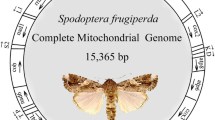Abstract.
Analysis of the 18S rDNA sequences of five species of the family Dugesiidae (phylum Platyhelminthes, suborder Tricladida, infraorder Paludicola) and eight species belonging to families Dendrocoelidae and Planaridae and to the infraorder Maricola showed that members of the family Dugesiidae have two types of 18S rDNA genes, while the rest of the species have only one. The duplication event also affected the ITS-1, 5.8S, ITS-2 region and probably the 28S gene. The mean divergence value between the type I and the type II sequences is 9% and type II 18S rDNA genes are evolving 2.3 times more rapidly than type I. The evolutionary rates of type I and type II genes were calibrated from biogeographical data, and an approximate date for the duplication event of 80–120 million years ago was calculated. The type II gene was shown, by RT-PCR, to be transcribed in adult individuals of Schmidtea polychroa, though at very low levels. This result, together with the fact that most of the functionally important positions for small-subunit rRNA in prokaryotes have been conserved, indicates that the type II gene is probably functional.
Similar content being viewed by others
Author information
Authors and Affiliations
Additional information
Received: 24 March 1998 / Accepted: 17 March 1999
Rights and permissions
About this article
Cite this article
Carranza, S., Baguñà, J. & Riutort, M. Origin and Evolution of Paralogous rRNA Gene Clusters Within the Flatworm Family Dugesiidae (Platyhelminthes, Tricladida). J Mol Evol 49, 250–259 (1999). https://doi.org/10.1007/PL00006547
Issue Date:
DOI: https://doi.org/10.1007/PL00006547




